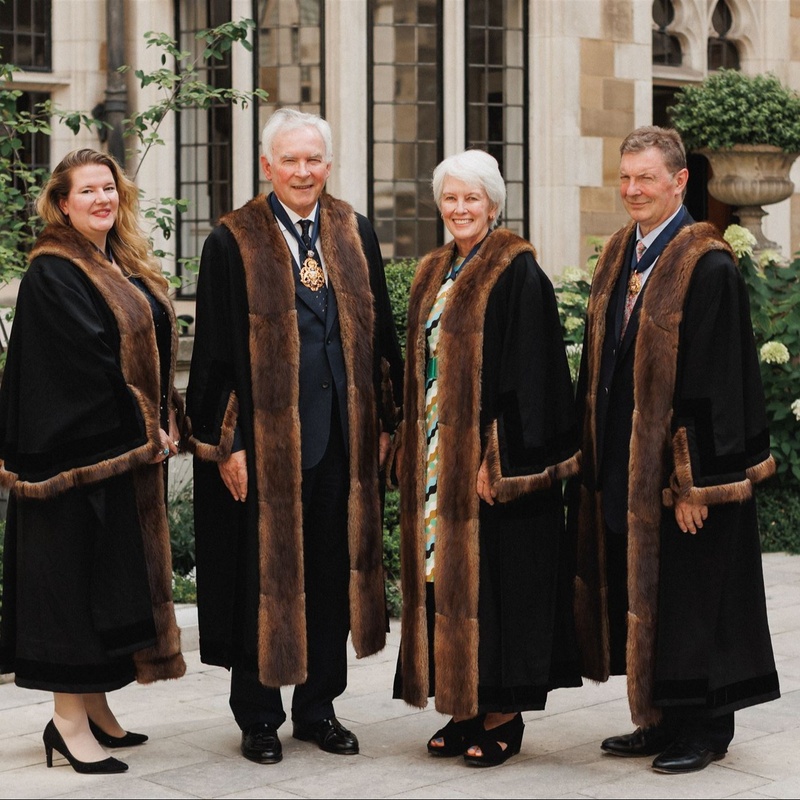

The Cloisters Fireplace
30 October 2019
The Cloisters are an important meeting space within Merchant Taylors' Hall. Which Merchant Taylor from the Company's annals of history has hurried through to enter the Court room? What gossip has been shared quietly by a window? Here, a Master and their Consort welcome guests to an event, members can socialise more informally between an event's proceedings, and refreshments are shared. Quietly in the corner is a fireplace. Look a bit closer however, and there is a mistake on the mantlepiece..
The fireplace in the Cloisters dates to 1857, and bears the names of the Master, Wardens and Clerk at that date. The Master was John Bonus (Master 1856-7); the Wardens were Bonamy Dobree junior, John Thompson Fletcher, John Watson Lay and Sir James Tyler. The Clerk was Samuel Fisher (whose portrait can be seen in the Parlour).
The fireplace includes a tall chimney piece of stone, with pilasters and cornice. This chimney piece bears a number of oval metal plates, painted with coats of arms. The central, largest plate has the arms of the Master, John Bonus. Curiously, the Latin of the motto has been painted incorrectly. The correct wording is a quotation from Ovid's Metamorphoses, Book II. It tells the tragic story of Phaethon, the son of Helios. In medio tutissimus ibis, “You will go most safely by the middle way.” However ibis has been rendered as ibio. This error was repeated in the new heraldic glass that was installed in the Great Hall in 1932 and destroyed in 1940. Presumably the glass was copied from the fireplace.
Surrounding the Master’s coat of arms are those of the four wardens. Dobree is in the top left, Fletcher in the top right, Lay in the lower left, and Tyler in the lower right. These are all smaller than the Master’s coat of arms, but still prominent. The final two shields, smaller still, are those of the Clerk, Samuel Fisher (bottom centre), and of the next Master, Joseph Turnley (top centre).

Not all of the coats of arms are original. Some were stolen in the early 1990s during building works, and replaced in 1994 with excellent modern facsimiles. These were copied from old photographs by Mr Sidney Bendall, a heraldic artist recommended by John Penton. The facsimile shields can be identified easily, being brighter and shinier than the surviving Victorian originals. The motto beneath the stolen Lay shield, Immortalium omnibus horissa, like the motto beneath the Master’s shield, was meaningless Latin, although it too had been re-used in the 1932 glazing scheme for the Great Hall. It probably should have read Nemo mortalium omnibus horis sapit [Alexander Pope], “No man always gets it right”. Mr Bendall recreated the meaningless version exactly as before.
The facsimile shields of Fletcher and Lay were also transposed. Fletcher was placed, not in the lower left, where it had been before, but in the top right, in the position formerly occupied by Lay. Lay was fixed where Fletcher should have been.
The present Cloisters date from 1927, when the fireplace was moved to its present position. It was originally installed in April 1857 in the East Corridor, then quite new, which had proved to be very cold. William Boulton was paid £70 for the stone chimneypiece. He may have re-used an existing hearth. He was not paid until the end of November 1857, so the fireplace was initiated in one Mastership and finished in another. This explains why we have the coat arms of Joseph Turnley (Master 1857-8.)
Stephen Freeth, Company Archivist

